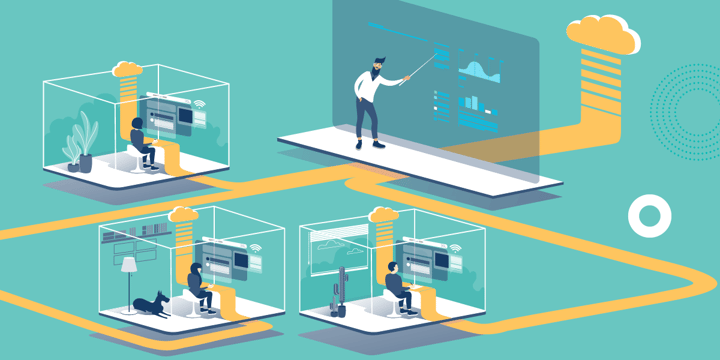It's no surprise that video conferencing platforms gained popularity during the pandemic. While COVID-19 changed the mode of living for many of us, the pace of life hasn't really slowed down. Whether you are meeting a new client, holding a weekly check-in, or even adding new hires at your nonprofit, video conferencing likely helped you complete these tasks.

This post will touch on the psychology behind video conferencing and how we can better connect with our colleagues in a distant virtual space. We had the pleasure of speaking with Susan Comfort, who is the founder of Comfort Consulting. She also co-directs NonprofitWellness.org and believes we need to talk as much about "team-care" as about self-care. Comfort's expertise spans wellness, the nervous system, and the digital workplace. Her interest in the brain science of taking breaks was spurred by leading Playworks DC, and 27 years overall in the nonprofit sector. Her background is in organizational development and wellness for team building.
The beauty of video conferencing is that it gives us the ability to connect with anyone, at any time, and any place. But if you'd like to replicate the feeling of an in-person workplace community online, read on. While we cannot make the pandemic go away with the snap of a finger, we can certainly provide some helpful tips for your next conference call.
The Brain Science Behind Video Conferencing
Understanding our central nervous system gives insight into our video conferencing experience. According to Comfort, when we are in a meeting, our brain feels that what we are experiencing is a regular conversation, but our nervous system is telling us that it is not. As a result, we may not feel safe or comfortable in that scenario.
Comfort tells us that the vagus nerve, which extends throughout the torso and feeds instant messages to the amygdala (our lizard brain), helps us judge "safety" or "danger." However, we don't get enough context clues during video conferencing to truly feel safe. Additionally, we have experiences, like seeing ourselves on camera, that are uncommon in live interactions. These can add to that subtle yet nagging feeling of discomfort. To summarize this concept, Comfort quotes tweets from Gianpiero Petriglieri, a psychiatrist who researches leadership development:
"I spoke to an old therapist friend today, and finally understood why everyone’s so exhausted after the video calls. It’s the plausible deniability of each other's absence. Our minds are tricked into the idea of being together when our bodies feel we're not. Dissonance is exhausting. …"
"It's easier being in each other's presence, or in each other's absence, than in the constant presence of each other's absence. …"
"Our bodies process so much context, so much information, in encounters, that meeting on video is being a weird kind of blindfolded. We sense too little and can't imagine enough. That single deprivation requires a lot of conscious effort."
Ultimately, our experience during a video call is impacted by our visual experience. Other mediums — phone calls for example — don't trick our brains into thinking we will get sensory information that is not available. While we cannot solve the fundamental issue of our brains being tricked, we can aim to make our brains feel safer.
Strategies for Building Deeper Trust on a Video Call
Comfort's first recommendation for fostering safety on a video call is to talk about wellness. Incorporating a wellness practice into a meeting might look like starting with a question that gives insight into your coworkers' daily lives. For your team, it might be helpful to take 15 to 30 seconds to ask questions like what do you do to bolster your mental health? What’s one vegetable you cooked or ate over the weekend? How do you ensure a good night’s sleep? Most people divulge only what they feel is safe to share with the group, yet there is inherent vulnerability in talking about wellness.
Asking these types of questions focused on physical or mental health can enable your team to experience a deeper connection with one another, and as a result, build trust and empathy. These moments of interconnectedness are what teams need most, and they can help minimize the cognitive dissonance sometimes experienced on a video call.
Another helpful strategy is to incorporate a 15-second stretch or movement activity into the meeting. This stretch is a great refresher and forces people to be fully present and attuned to their senses. It's also a great way to create cohesion and connectedness as each team member is partaking in an activity aside from work and collectively destressing. By including movement into an otherwise sedentary meeting, your team may also experience another layer of vulnerability as you practice an activity that may not be a part of normal meeting convention.
These strategies tie into gauging social cues online. It might be helpful to revisit your online group agreements. Your team's list might include solutions for common video calling challenges like sitting a lot, a lack of group discussion, a lack of personal connection, and how to build in more and better time for breaks.
Additionally, consider alternative ways to take an already scheduled meeting or to diversify ways to experience a meeting. For example, you might call in to a meeting (when appropriate) instead of being on camera, or even participate while you're taking a walk. You could also decide, as a group, to alternate the time you spend with your camera on and off. As Comfort points out, if the main reason to have cameras on is to ensure that workers are present, or paying attention, that might indicate a lack of trust. If allowing cameras off makes some people feel safer and more trusted, it's worth trying.
These activities create opportunities to integrate wellness into your daily work life beyond breaks. Diversifying your practices and revisiting group agreements encourage a culture of mental preparation, resilience, and restoration for your team.
Self-Care vs. Team-Care
The era of video conferencing offers new opportunities to take care of ourselves and each other in intentional ways. One way to bolster your team's wellness is to expand beyond self-care by focusing on team-care.
A key distinction between team-care and self-care is that the responsibility to take care of one's mental and emotional state is not completely placed on the individual. Comfort points out that in the nonprofit world, "we are not so good at self-care." Therefore, as a team, there can be a sense of accountability for one another. We can focus on the fundamental idea that we need to take care of each other as we share our lives in the workplace. Team-care is fueled by empathy, which is essential in any workplace and vital for an individual's ability to be resilient and do well at their job.
According to Comfort, team-care speaks to the importance of wellness in the nonprofit workplace, where staff are oftentimes used to being "givers." Since helping others comes more naturally than self-care, this means a culture of caring for others (team-care) can be easily nurtured. However, health solutions aren't one-size-fits-all. Each individual has unique wellness needs (not to mention different norms about sharing intimate bodily details). Ultimately, it's also up to leaders in an organization to model the shift to a wellness-focused mindset.
Understanding more about how our nervous system functions can help us build connections and trust in a world with COVID. While remote work has brought new challenges, it also presents an opportunity to build new practices and habits that deviate from workplace norms that we have had for years. This may very well create new and better workplace cultures that help employees manage stress and build deeper trust with one another in the years ahead.
Additional Resources
- Take TechSoup Courses' series Creating an Engaging Virtual Event, Meeting, or Conference.
- See about Understanding the Video Conferencing Tools Available to Your Nonprofit
-
Get 8 Tips for Holding Virtual Meetings During the COVID-19 Pandemic
Top photo: Shutterstock








